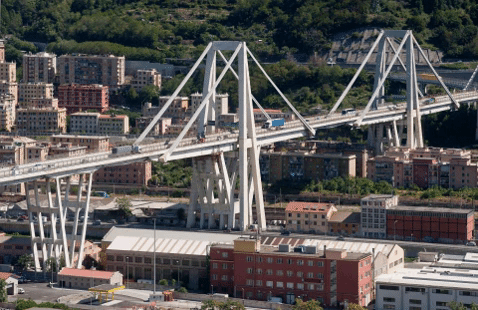Morandi bridge a week on: the key thing, I believe, is a lack of structural redundancy. For the bridge to collapse as it did, something needed to give way – and it was unlikely to be a member in compression, so that rules the struts out. We know the tower remained standing after the roadway had gone, and then first one side of the giant pylon twisted and crashed, and then the next side did the same – in the opposite direction. That implies torsion – and where else is it going to get torsion, except from one of the giant cable-stays collapsing before the other, and twisting the tall thin pylons around their axis. They weren’t made to twist – they didn’t stand a chance.
So I’ve put together a small animation – something sets the whole catastrophe in motion – and the consensus so far seems to be that it is likely to be the corroded steel and concrete stays. Apparently the concrete used to encase the steel was only poured at 10 MpA – predictably therefore, the concrete was crumbling and the stays were suffering from rust and perhaps other damage. Perhaps they were hit by lightening. Perhaps a truck went out of control in the wet and spun out and hit the cable, but whatever caused the crack, one of those mighty cable stays was severed – and then instantly the entire structure went from a situation dynamically counter-balanced at rest, and turned it into a horrible twisting, flailing mess in which the rest of the structure could not survive. There was no structural redundancy once one cable had gone….
The central “drop-in” span would have disappeared quite quickly as the main deck started to subside, dropping out and down onto the tracks 45m below. The remaining load then transfers from the deck onto the one remaining cable stay – and there’s no way that single cable could hold up the bridge one-handed, so to speak. But it tries – so it resists the falling deck, and pulls hard against gravity – and so induces fierce torsion into the tall inverted V pylon, causing cracking and splintering. Now the other side goes too, and the central heavily strutted structure caves into itself centrally. It rips off the other side – paradoxically, the rapid separation leaves a stable structure on either side. The pylon collapses and just the two side spans now remain standing.
Something like that anyway.
The authorities will likely conclude something like this in a few months or a year or two, but it seems fairly obvious on the sequence of events – just not the crucial question “why?”. Morandi used this same design of bridge in a number of other bridges too, with the giant pair of cable stays – one in Venezuela (General Rafael Urdaneta Bridge, which partially collapsed in 1964), one in Libya (the huge Wadi el Kuf bridge, now closed due to fears of collapse?) and others in Canada, Ecuador, Columbia, and of course, several more in Italy. He was a great bridge builder of some structurally proud exciting bridges, but after this calamity, sadly, his name will probably always be associated with disaster.





Well, I should probably be doing something else in the evening but last night was rainy and I thought- why not ? So, by virtue of my world-class animation skills, I’ve whipped up this stunning (crude) animation. Whaddya reckon ?
Thanks, Levi – excellent!
A minor quibble: from the video it looks as if the sequence of collapse at the northern end (the nearer end in your animation) was deck, then west side of tower, then east side of tower.
And do we know that the deck between the two towers was the first bit to collapse, or is that an educated guess?
Betterbee – do I know that the deck in the middle was the first bit to go? Absolutely not, I can’t say that I “know” anything. I’m purely proposing a hypothesis about what might have happened, leading to a sequence of events. The middle bit of the deck, called the “drop in”, could conceivably have dropped out by itself, but what would cause that to happen? And even if it did, why would the rest of the bridge then fall down? Makes no sense.
But if we assume that one of the cable-stays was the first to go, then that takes a stable system, and suddenly imputs a whole new dimension into the equation. Suddenly, everything wants to twist. Twist the bridge deck and what happens first? The part that was the last to be dropped in, now drops out. The deck continues to swing to the side and to twist along its length, collapsing into the stream below, and further imbalancing the system etc. Then the next stay goes, then the other side etc. Its one of those situations that, once started, can’t possibly stay still until the collapse sequence has concluded.
There’s a relevant item at https://www.newcivilengineer.com/latest/revealed-collapsed-italy-bridge-construction-photos-and-designs/10034288.article?blocktitle=Most-popular&contentID=-1 – “New Civil Engineer exclusively reveals a 1960s report detailing the construction methods and designs behind the collapsed Morandi bridge in Genoa.” It’s paywalled, so I haven’t read it.
Thanks Betterbee – there’s a lot of interesting things in there, great link thanks.
Levi,
Please submit your animation portfolio to Weta Digital, forthwith! =)
[…] http://eyeofthefish.org/lack-of-structural-redundancy/ […]
You might like to read this article….
https://genuinebritishengineer.wordpress.com/2018/09/20/uk-engineers-query-claims-44t-lorry-triggered-italy-bridge-collapse-19-september-2018/